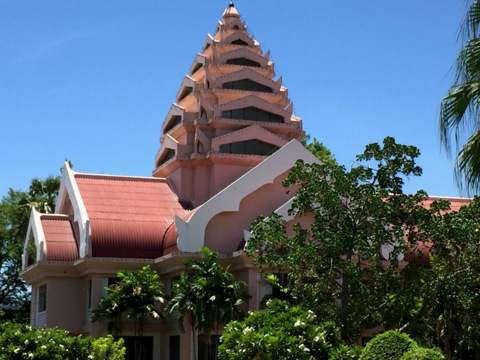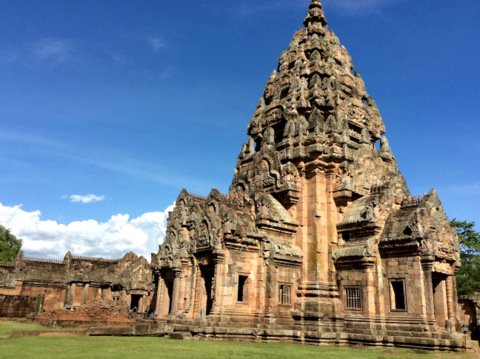| Back to Back Issues Page |
 |
|
Bangkok Travelbug July 2016 Treasures of Buriram June 28, 2016 |
| Hello
Volcanoes in Buriram Buriram has several extinct volcanoes; these are volcanoes that are cut off from their lava supply or no longer near a geologic hotspot owing to the gradual shift in the plates in the earth’s crust. An extinct volcano is one that hasn’t erupted for at least 10,000 years. Extinct volcanoes are the result of mega eruptions that bury land under thick layers of lava and wipe out animal and plant life. 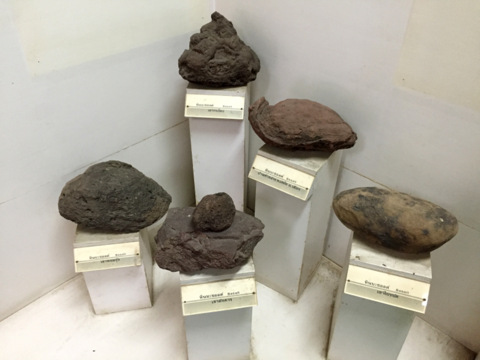
Basalt rocks formed by rapid cooling of lava found in Buriram Many of these extinct volcanoes in Buriram have become tourist attractions today, for example:
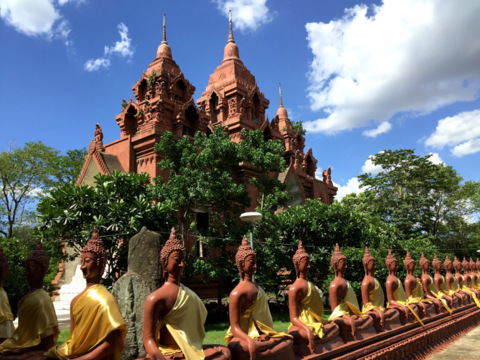
Wat Khao Phra Angkhan Contents Ancient Communities in South Isarn Excavations by archaeologists have revealed evidence of early life in the South Isarn Region. These early settlers migrated from Ban Chiang and Sakhon Nakhon in the north and moved south to Nakhon Ratchasima. For security these settlers grouped themselves in communities built on hillocks or surrounded by moats with high embankments. From examinations of the tools, weapons, ornaments and pottery used by these communities, archaeologists concluded that these communities existed about 2,500 to 3,000 years ago, in the New Stone Age Around 1000 - 1300 AD there was clear evidence of a greater prosperity among communities south of the Mun River basin and in the foothills of the Dongrak Mountains compared to those in the Mun River basin. The communities in the foothills built their houses in a rectangular or square formation clustered around a religious shrine. They also had the benefit of the flow of water from the mountains resulting in reservoirs and irrigation canals that improved their lives tremendously. Contents Khmer Sanctuaries in South Isarn The rise of prosperous communities south of the Mun River basin coincided with the emergence of the Khmer Empire in Angkor, Cambodia in the 9th C. Its influence soon spread over large parts of Thailand covering parts of South Isarn. The Khmers built roads, bridges, canals and reservoirs in these areas. Most importantly they left a legacy of stone sanctuaries in many provinces in South Isarn; nine in Surin, eight in Korat, eight in Si Saket and three in Khon Kaen. There are six of these sanctuaries in Buriram:
The sculptures in these sanctuaries indicate Hindu and Mahayana Buddhist influence. The two most prominent sanctuaries are Prasat Phanom Rung and Prasat Mueang Tam. 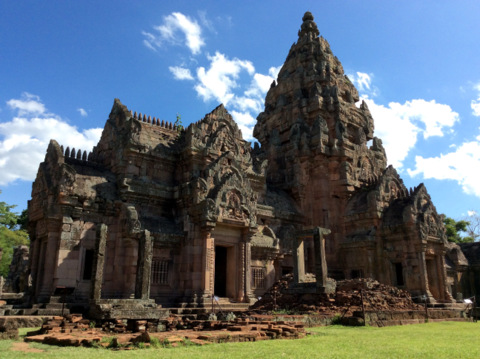
Prasat Phanom Rung 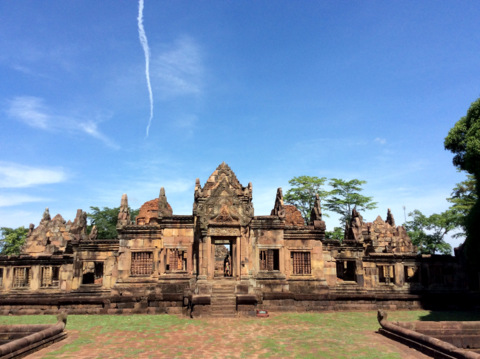
Prasat Mueang Tam There’s an ancient quarry in Ban Kruat District in Buriram where the stones for these sanctuaries were cut and transported to the construction sites. The huge rocks in this quarry are scattered all over a forested area and many of these rocks show sharp cuts to indicate that a portion has been hacked off. 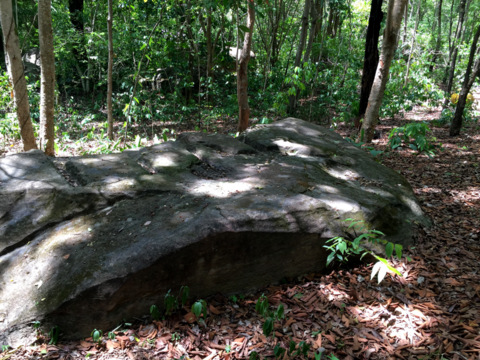
Note the sharp cut in the rock There also a forest temple located in this quarry. These are monasteries located in remote areas where monks stay to meditate. Contents Ethnic Groups in South Isarn This section on the ethnic groups in South Isarn shows the cultural and ethnic diversity of the people in this region which makes them distinct from the rest of Thailand. The murals on the interior walls of the central tower depict these four groups and the festivals celebrated throughout the year. These murals were painted by Art students and lecturers of the Buriram Teachers’ College from 1990 – 1991. There are four major ethnic groups in south Isarn viz: Thai Suay or Kui The Suay or Kui are related to the Ka, a Mon Khmer tribe that lives in North Thailand, both ethnic groups have a similar language. The Kui were originally inhabitants of Champasak in South Laos. Owing frequent wars in the past, they migrated to Si Saket, Surin and Buriram in Thailand. Traditionally the Kui are very skilful elephant handlers, they are able to capture wild elephants and train them, what they have been doing for generations. 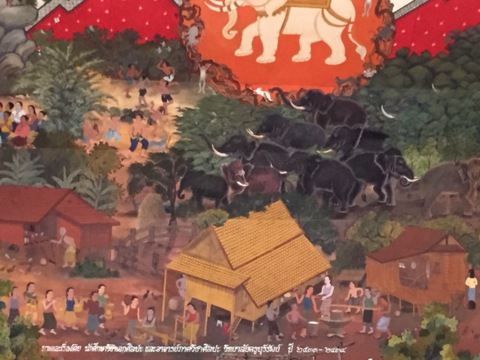
The Thai-Kui in an elephant roundup Because of this life-style they prefer to live near forests so that the elephants can find food and breed in the forests. Today many of them live in Satuek District in the north, near the Mun River and Surin Province. Thai Khmer As far back as 3,000 years ago the South Isarn area between the Mun River basin and the foothills of the Dongrak was already inhabited. The people who were closest to this region and who had the best access were the Khmers in the Ton Le Sap area in Cambodia. By 1,000 AD, the Khmer influence in the region started to be felt. The Khmer sanctuaries in Korat and Buriram attracted large communities around them because of the availability of water. 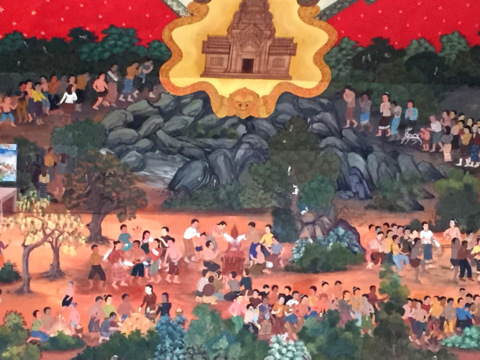
The Thai Khmer and the tower of Prasat Phanom Rung Immigration increased through the mountain passes in the Dongrak Range into South Isarn with most of the Khmers settling in Buriram. Thai Korat There is evidence of life in Korat since the pre-historic period. This is reinforced by the report about a place called Ban Prasat 45 km north of Korat City. The three excavation pits here contain skeletons, ceramic pots, bronze, jewellery and glass beads belonging to an agricultural society that is about 3,000 years old! In the Dvaravati period (6th – 11th C) there existed a civilisation in Sung Neon 30 km south of Korat City. During the Khmer Empire (12th - 14th C) a sanctuary was built in Phimai which became a centre of population as well. The Korat ethnic group refers to the people from Nakhon Ratchasima or Korat for short. The Korat ethnic group is also a mix of different people. 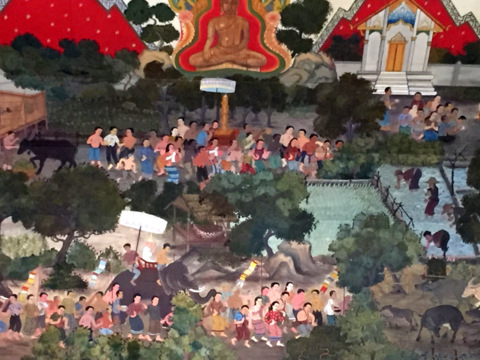
The wooden Buddha symbolic of the Thai Korat The majority are Thai Lao or Thai Isan like those from the rest of Isarn. The main wave of migrants settled here after the destruction of Vientiane in 1827, others followed later. The second ethnic group under the Thai Korat group are the Mon most of whom migrated to Korat in 1775 during the Thonburi era. As a community they still preserve their customs and traditions. The older Mon (those over 60 years) still speak the Mon language though the younger ones have switched to the Thai-Korat dialect. The Thai-Korat dialect uses words similar to the Central Thai dialect but with a different pronunciation and tone. It is similar to the Lao dialect probably because the early Lao immigrants adapted their language to Thai resulting in the creation of a unique accent. Thai Lao The Lao were originally from the Lan Chang Kingdom in present day Laos. The kingdom covered both banks of the Mekong River and included Thai provinces like Nakhom Phanom, Ubon Ratchathani. 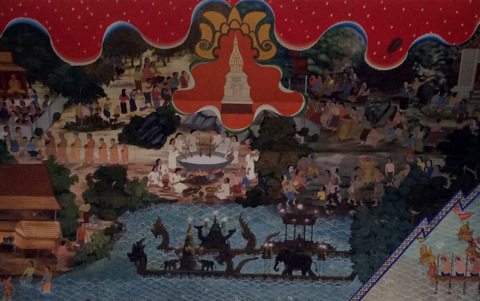
Mural of the chedi Phra That Phanom representing the Thai Lao Again it was wars that caused them to migrate further south to the Mun River basin. Besides voluntary migration, many Lao were also forcibly resettled to the Korat Plateau and Isarn during the wars between Siam and Vientiane in the reigns of King Rama I and King Rama III. The Thai Lao are the most numerous ethnic group in South Isarn and speak a dialect very similar to the Lao language. Contents Pottery More than 1,000 years ago, there was a striving pottery industry in Buriram that produced not only for domestic use but for the surrounding areas as well. There were more than 200 kilns in the area of Ban Kruat, Krasang and Laharn Sai in the southern parts of province close to the Cambodian border. The pottery in this area and during this period also showed a higher degree of refinement compared to the pottery of earlier periods. Products consisted of glazed pottery with different colours, not only pots and containers but glazed roof and eaves tiles as well. 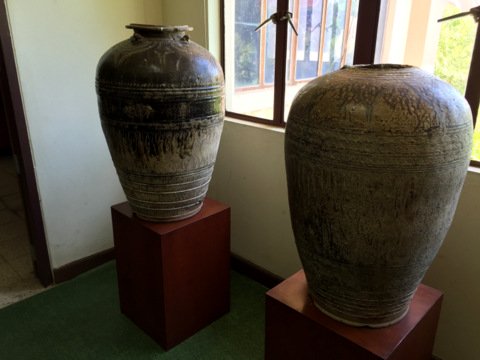
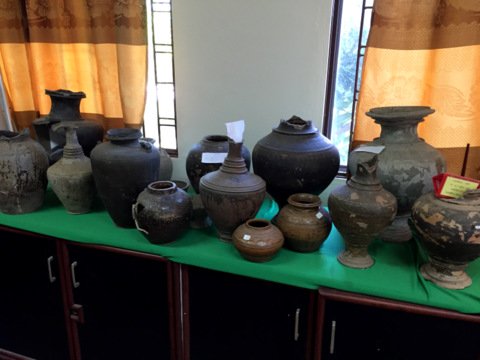
Old pottery on display From the 10th – 14th C, the pottery here is believed to be influenced by China or initiated by Chinese artisans. The kilns used during this period were of the cross draft type with a firing box where fires were started, separate compartments for different types of pottery and a chimney. 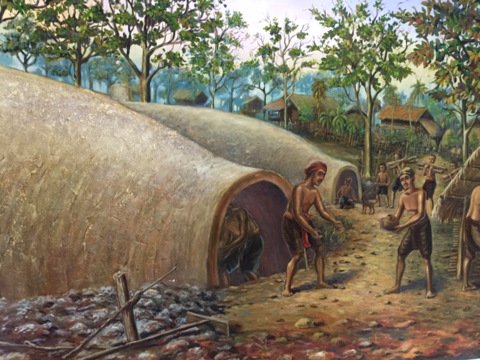
Painting of an ancient kiln Today only two of these ancient kilns remain at Nai Chian and Sawai in Ban Kruat District, Buriram. These kilns, dated between the 10th and 14th C were made from clay reinforced with bamboo then left to dry. The kiln at Nai Chian is 12 m by 8 m and can heat a few hundred pieces of pottery at the same time. 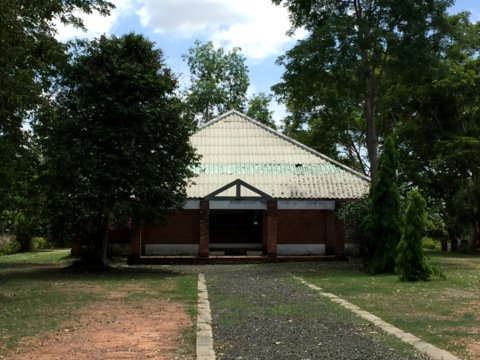
Building housing the kiln at Nai Chian 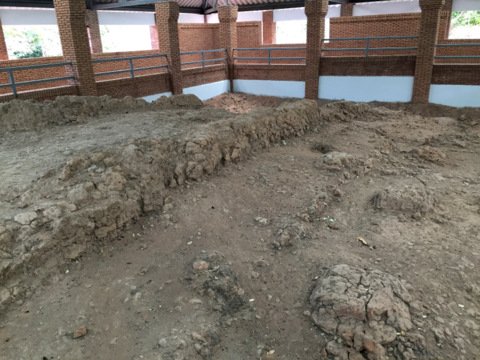
Remains of the ancient kiln at Nai Chian The ancient pottery discovered in this area is displayed in the Lower North-eastern Cultural Centre in Buriram City. Contents Thai silk of Buriram On the way to Buriram along Highway 218, we came across a Thai silk weaving group in Tambon Nong Kong. We stopped to look at the Thai silk on display, they were just beautiful. 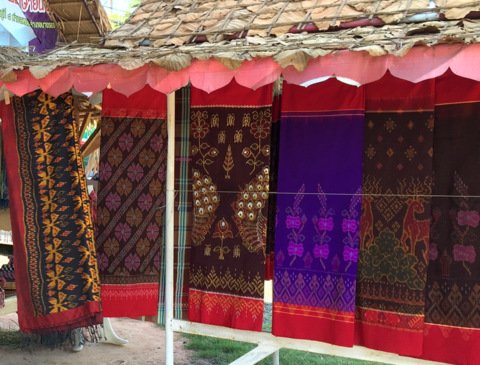
Some of the silks on display What’s more we were lucky enough to see some work in progress in the house next to the stall. One resident was boiling the cocoons to extract the silk. Raw, untreated silk costs about 500 baht per kg. After bleaching and dying it can cost 1,500 baht per kg. 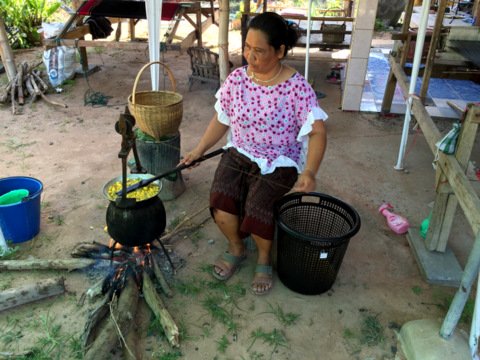
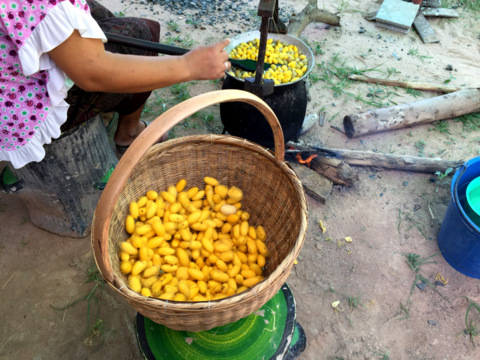
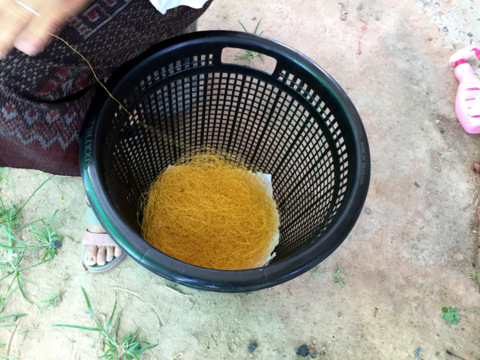
Extracting the silk thread from the cocoons The silk worms extracted from the cocoons are a delicacy in Isarn; they are eaten boiled or deep-fried. 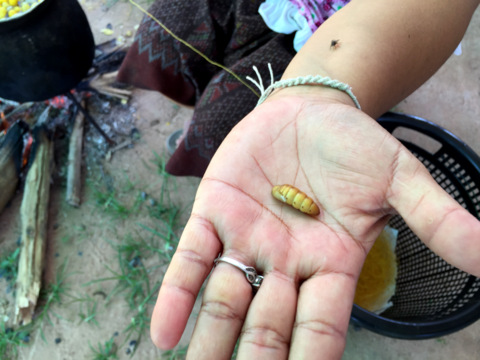
The by-product Yai (granny) is 76 years old and still actively weaving her silk while chewing on her favourite betel leaves. 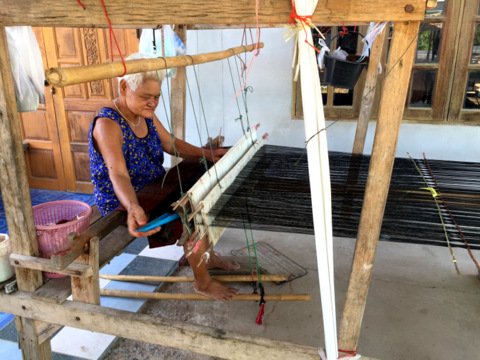
The doyen of the silk weavers The lady manning the silk stall explained that many of these silk designs are personal, frequently passed down through the generations. That’s why we can have a wide variety of colours and patterns. Here are some of the silk we bought as souvenirs. 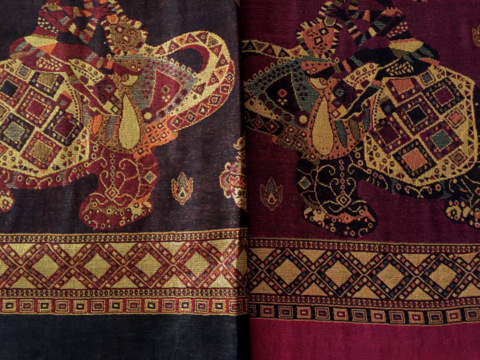
Souvenirs of Buriram Contents Rainbow Hill Hotel Most of the historical sites covered in this account are south of Highway 24. These sites like Phanom Rung are within 40 km of a town called Nang Rong which has a number of comfortably and reasonably priced hotels. Nang Rong is 50 km south of Buriram City, so you save yourself a great deal of travelling than if you stayed in Buriram City. Rainbow Hill Hotel is 10 km outside Nang Rong and it’s a homely and pleasant place to stay. It’s on the main road and easy to find and there’re wide open expanses of rice fields and farm land just next to it. 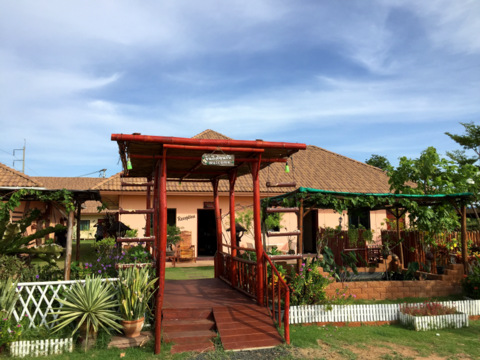
Rainbow Hill Hotel, Nang Rong Papaya for the som tam served by the kitchen comes from the garden in the hotel grounds. The rice comes from the rice field nearby. 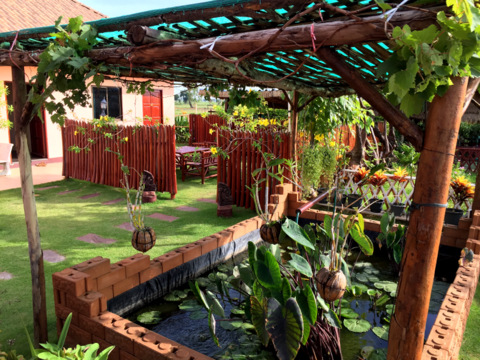
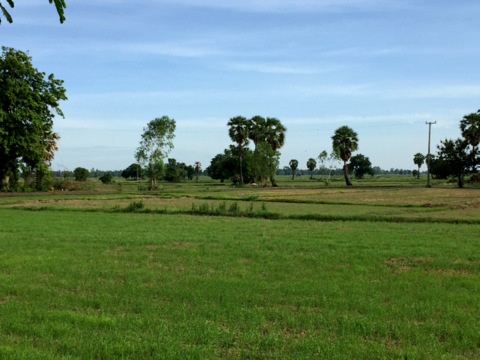
Garden and farm land around the hotel Contents My thanks Khun Pitchaporn Wongkhum of the Lower North-eastern Cultural Centre for conducting the tour of the centre and for all the information provided in the form of the information booklet and DVDs on Buriram tourist attractions. My thanks for permission to photograph exhibits in the Lower North-eastern Cultural Centre. Residents of Nong Kong for showing us their silk handicraft, in the relentless pursuit of ever changing technology, sometimes it’s the wisdom of our forefathers that is more enduring. Khun Samran and her husband who run the Rainbow Hill Hotel for their pleasant service and wonderful food from the kitchen. Contents Map of Buriram Treasures If the map doesn’t appear, click on this link How to get there By car From Bangkok - Vibhawadi Rangsit Road - past Don Mueang Airport - Highway 1 – Saraburi – Highway 2 – Highway 24 to Pak Thong Chai – continue on to Nong Rong. From Nang Rong you can continue north along Highway 218 to Buriram or base yourself in Nang Rong which is more convenient as all but one of the places mentioned is near Nang Rong. Avoid using Highway 226 linking Buriram City to Korat as it’s a single lane road for part of the way and travel will be slow. You will also get stuck in the traffic in Korat City. Use Highway 24 that passes Pak Thong Chai, it’s a dual carriageway and traffic is light. Contact Information Lower North-eastern Cultural Centre Rajabhat University Buriram Jira Road Buriram City Tel: 0 4461 1221 ext. 159 Opening hours The centre is open every day from 0900 – 1600 hours Nong Kong Thai Silk Weaving Group 99 Mu 4 Tambon Nong Kong Amphur Nang Rong Buriram 3110 Tel: 085 225 2096 Rainbow Hill Hotel 126 Mu 13 Ban Khok Tabek (Highway 24 ) Tambon Isarn Khet Amphur Chaloem Phrakiat Buriram 31110 Tel: 080 815 6413 Please note that although the hotel is near Nang Rong, it’s located in the neighbouring Chaloem Phrakiat District. Contents Next month Prasart Muang Tam, Buriram If you enjoyed reading this e-zine, please forward it to a friend. If you received this from a friend and found it interesting, please subscribe at Bangkok Travelbug. What do you think of the Bangkok Travelbug? We love to hear from you What other subscribers have said Till next month then. Eric Lim Tour Bangkok Legacies Find us on Facebook If you are an independent traveller, here's a handy e-guide book, Tour Bangkok Legacies, which will help you along as you explore the streets of Bangkok and discover its old treasures. It's complete with historical descriptions, maps and detailed directions on how to get to these places. My Kindle e-book 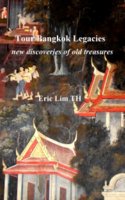
Copyright@2008-2016 Tour Bangkok Legacies All rights reserved
|
| Back to Back Issues Page |
